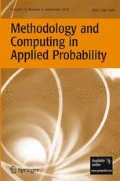Abstract
In the paper we introduce a flexible inhomogeneous space-time shot-noise Cox process model and derive a two-step estimation procedure for it. In the first step the inhomogeneity is estimated by means of a Poisson score estimating equation and in the second step we use minimum contrast estimation based on second order properties to obtain estimates of the clustering parameters. The suggested model is not separable but it has a special interaction structure which enables to use the spatial and temporal projections of the process for parameter estimation. Efficiency of the introduced method is investigated by means of a simulation study and it is compared to a previously used method.
Similar content being viewed by others
References
Baddeley AJ, Møller J, Waagepetersen R (2000) Non- and semiparametric estimation of interaction in inhomogeneous point patterns. Stat Neerlandica 54:329–350
Baddeley AJ, Turner R (2005) Spatstat: an R package for analyzing spatial point patterns. J Stat Softw 12:1–42
Brix A (1999) Generalized gamma measures and shot-noise Cox processes. Adv Appl Probab 31:929–953
Brix A, Diggle PJ (2001) Spatiotemporal prediction for log-Gaussian Cox processes. J R Stat Soc B 63:823–841
Brix A, Møller J (2001) Space-time multi type log Gaussian Cox processes with a view to modelling weed data. Scand J Statist 28:471–488
Daley DJ, Vere-Jones D (2003) An introduction to the theory of point processes. Elementary Theory and Methods, vol 1. Springer, New York
Daley DJ, Vere-Jones D (2008) An introduction to the theory of point processes. General Theory and Structure, vol 2. Springer, New York
Diggle PJ, Chetwynd AG, Häggkvist R, Morris S (1995) Second-order analysis of space-time clustering. Stat Methods Med Res 4:124–136
Diggle P (2003) Statistical analysis of spatial point patterns, 2nd edn. Oxford University Press, New York
Diggle P (2007) Spatio-temporal point processes: methods and applications. In: Finkenstädt B, Held L, Isham V (eds) Statistical methods for spatio-temporal systems. Chapman and Hall/CRC, Boca Raton
Dvořák J, Prokešová M (2012) Moment estimation methods for stationary spatial Cox processes—a comparison. Kybernetika 48:1007–1026
Gabriel E, Diggle P (2009) Second-order analysis of inhomogeneous spatio-temporal point process data. Stat Neerlandica 63:43–51
Guan Y (2009) A minimum contrast estimation procedure for estimating the second-order parameters of inhomogeneous spatial point processes. Stat Interface 2:91–99
Hellmund G, Prokešová M, Vedel Jensen EB (2008) Lévy-based Cox point processes. Adv Appl Probab 40:603–629
Illian J, Penttinen A, Stoyan H, Stoyan D (2008) Statistical analysis and modelling of spatial point patterns. Wiley, Chichester
Møller J, Syversveen AR, Waagepetersen RP (1998) Log-Gaussian Cox processes. Scand J Statist 25:451–482
Møller J (2003) Shot noise Cox processes. Adv Appl Probab 35:614–640
Møller J, Waagepetersen RP (2003) Statistical inference and simulation for spatial point processes. Chapman and Hall/CRC, Florida
Møller J, Ghorbani M (2012) Aspects of second-order analysis of structured inhomogeneous spatio-temporal point processes. Stat Neerlandica 66:472–491
Prokešová M (2010) Inhomogeneity in spatial Cox point processes—location dependent thinning is not the only option. Image Anal Ster 29:133–141
Stoyan D, Stoyan H (1994) Fractals, random shapes and point fields: methods of geometrical statistics. Wiley, Chichester
Thomas M (1949) A generalization of poisson’s binomial limit for use in ecology. Biometrika 36:18–25
Waagepetersen RP, Guan Y (2009) Two-step estimation for inhomogeneous spatial point processes. J R Stat Soc B 71:685–702
Author information
Authors and Affiliations
Corresponding author
Rights and permissions
About this article
Cite this article
Prokešová, M., Dvořák, J. Statistics for Inhomogeneous Space-Time Shot-Noise Cox Processes. Methodol Comput Appl Probab 16, 433–449 (2014). https://doi.org/10.1007/s11009-013-9324-0
Received:
Revised:
Accepted:
Published:
Issue Date:
DOI: https://doi.org/10.1007/s11009-013-9324-0
Keywords
- Shot-noise Cox process
- Minimum contrast estimation
- Space-time point process
- Space-time K-function
- Pair-correlation function
- Projection processes




